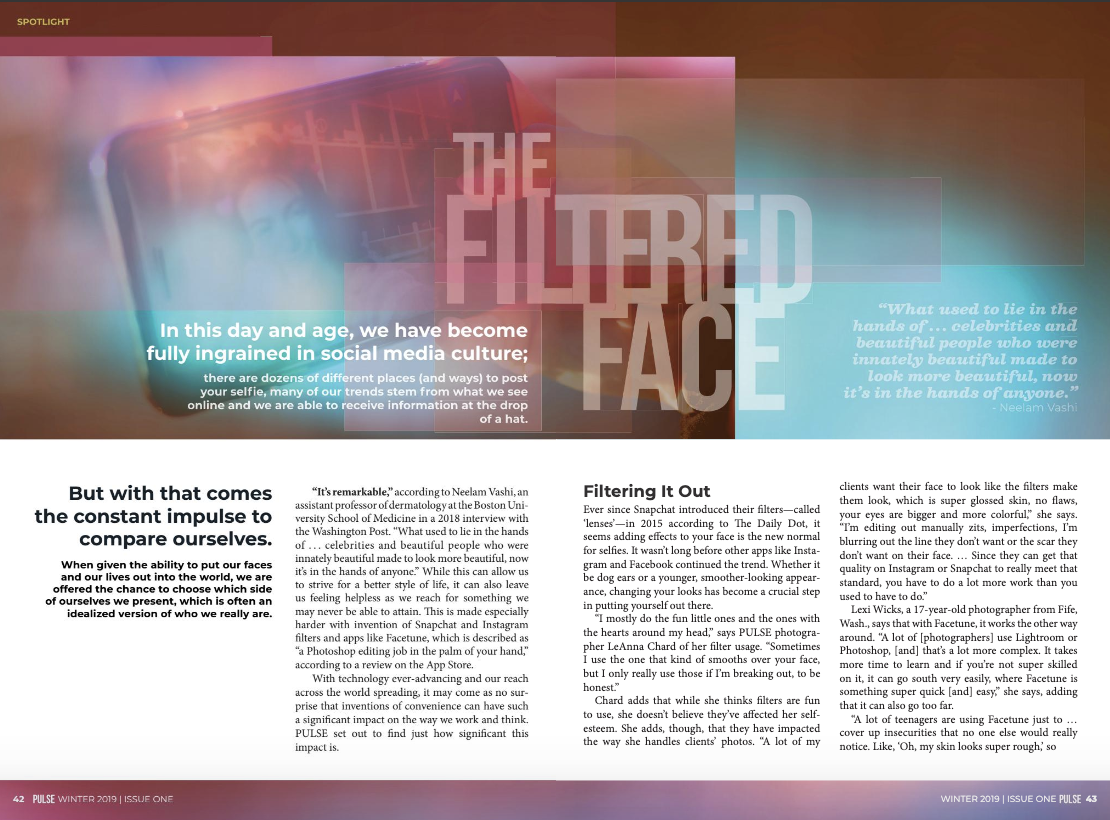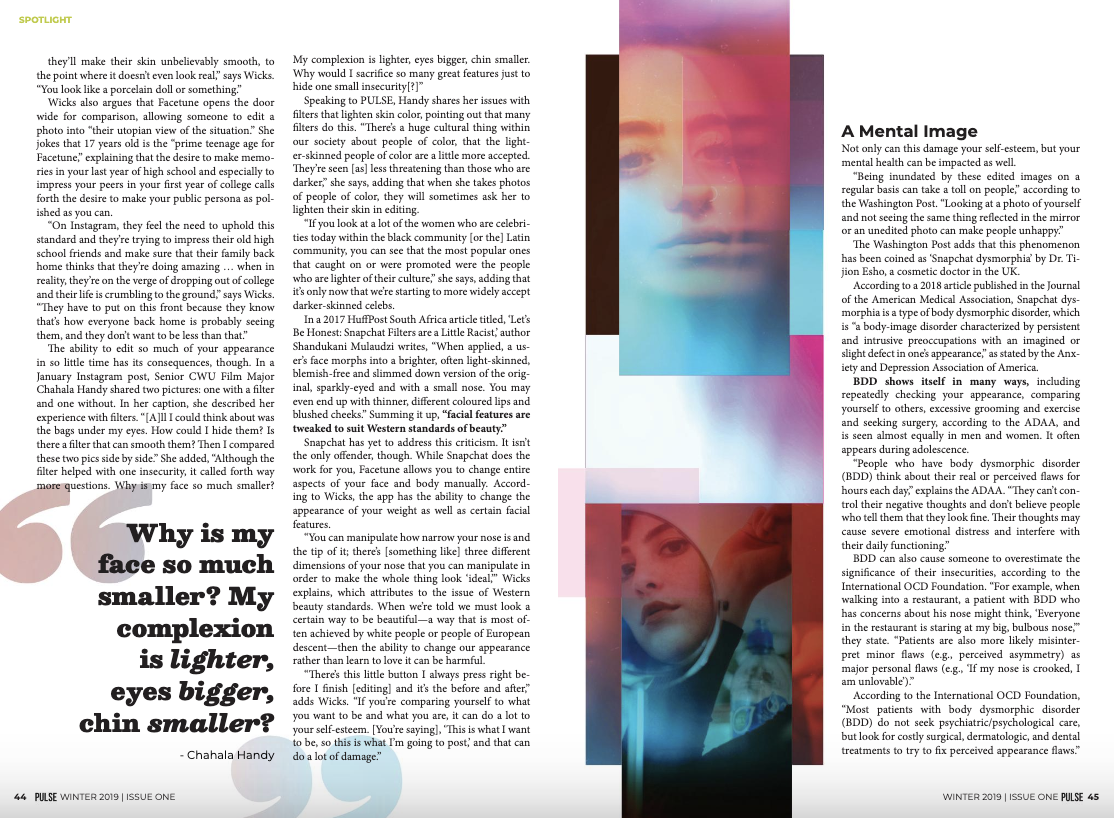The Filtered Face
Story by Lexi Phillips | Photos by LeAnna Chard | Design by Isabelle Grotting
In this day and age, we have become fully ingrained in social media culture; there are dozens of different places (and ways) to post your selfie, many of our trends stem from what we see online and we are able to receive information at the drop of a hat. But with that comes the constant impulse to compare ourselves. When given the ability to put our faces and our lives out into the world, we are offered the chance to choose which side of ourselves we present, which is often an idealized version of who we really are.
“It’s remarkable,” according to Neelam Vashi, an assistant professor of dermatology at the Boston University School of Medicine in a 2018 interview with the Washington Post.
“What used to lie in the hands of . . . celebrities and beautiful people who were innately beautiful made to look more beautiful, now it’s in the hands of anyone.”
While this can allow us to strive for a better style of life, it can also leave us feeling helpless as we reach for something we may never be able to attain. This is made especially harder with invention of Snapchat and Instagram filters and apps like Facetune, which is described as “a Photoshop editing job in the palm of your hand,” according to a review on the App Store. With technology ever-advancing and our reach across the world spreading, it may come as no surprise that inventions of convenience can have such a significant impact on the way we work and think. PULSE set out to find just how significant this impact is.
Filtering It Out
Ever since Snapchat introduced their filters—called ‘lenses’—in 2015 according to The Daily Dot, it seems adding effects to your face is the new normal for selfies. It wasn’t long before other apps like Instagram and Facebook continued the trend. Whether it be dog ears or a younger, smoother-looking appearance, changing your looks has become a crucial step in putting yourself out there. “I mostly do the fun little ones and the ones with the hearts around my head,” says PULSE photographer LeAnna Chard of her filter usage. “Sometimes I use the one that kind of smooths over your face, but I only really use those if I’m breaking out to be honest.” Chard adds that while she thinks filters are fun to use, she doesn’t believe they’ve affected her self-esteem. She adds, though, that they have impacted the way she handles clients’ photos. “A lot of my clients want their face to look like the filters make them look, which is super glossed skin, no flaws, your eyes are bigger and more colorful,” she says. “I’m editing out manually zits, imperfections, I’m blurring out the line they don’t want or the scar they don’t want on their face . . . Since they can get that quality on Instagram or Snapchat to really meet that standard, you have to do a lot more work than you used to have to do.” Lexi Wicks, a 17-year-old photographer from Fife, Wash., says that with Facetune, it works the other way around. “A lot of [photographers] use Lightroom or Photoshop, [and] that’s a lot more complex. It takes more time to learn and if you’re not super skilled on it, it can go south very easily, where Facetune is something super quick [and] easy,” she says, adding that it can also go too far. “A lot of teenagers are using Facetune just to . . . cover up insecurities that no one else would really notice. Like, ‘Oh, my skin looks super rough,’ so My complexion is lighter, eyes bigger, chin smaller. Why would I sacrifice so many great features just to hide one small insecurity[?]” Speaking to PULSE, Handy shares her issues with filters that lighten skin color, pointing out that many filters do this. “There’s a huge cultural thing within our society about people of color, that the lighter skinned people of color are a little more accepted. They’re seen [as] less threatening than those who are darker,” she says, adding that when she takes photos of people of color, they will sometimes ask her to lighten their skin in editing. “If you look at a lot of the women who are celebrities today within the black community [or the] Latin community, you can see that the most popular ones that caught on or were promoted were the people who are lighter of their culture,” she says, adding that it’s only now that we’re starting to more widely accept darker-skinned celebs. In a 2017 Huff Post South Africa article titled, ‘Let’s Be Honest: Snapchat Filters are a Little Racist,’ author Shandukani Mulaudzi writes, “When applied, a user’s face morphs into a brighter, often light-skinned, blemish-free and slimmed down version of the original, sparkly-eyed and with a small nose. You may even end up with thinner, different coloured lips and blushed cheeks.” Summing it up, “facial features are tweaked to suit Western standards of beauty.” Snapchat has yet to address this criticism. It isn’t the only off ender, though. While Snapchat does the work for you, Facetune allows you to change entire aspects of your face and body manually. According to Wicks, the app has the ability to change the appearance of your weight as well as certain facial features. “You can manipulate how narrow your nose is and the tip of it; there’s [something like] three different dimensions of your nose that you can manipulate in order to make the whole thing look ‘ideal,’” Wicks explains, which attributes to the issue of Western beauty standards. When we’re told we must look a certain way to be beautiful—a way that is most often achieved by white people or people of European descent—then the ability to change our appearance rather than learn to love it can be harmful. “There’s this little button I always press right before I finish [editing] and it’s the before and after,” adds Wicks. “If you’re comparing yourself to what you want to be and what you are, it can do a lot to your self-esteem. [You’re saying],
“This is what I want to be, so this is what I’m going to post, and that can do a Lot of damage.”
A Mental Image
Not only can this damage your self-esteem, but your mental health can be impacted as well. “Being inundated by these edited images on a regular basis can take a toll on people,” according to the Washington Post. “Looking at a photo of yourself and not seeing the same thing reflected in the mirror or an unedited photo can make people unhappy.” The Washington Post adds that this phenomenon has been coined as ‘Snapchat dysmorphia’ by Dr. Tijion Esho, a cosmetic doctor in the UK. According to a 2018 article published in the Journal of the American Medical Association, Snapchat dysmorphia is a type of body dysmorphic disorder, which is “a body-image disorder characterized by persistent and intrusive preoccupations with an imagined or slight defect in one’s appearance,” as stated by the Anxiety and Depression Association of America. BDD shows itself in many ways, including repeatedly checking your appearance, comparing yourself to others, excessive grooming and exercise and seeking surgery, according to the ADAA, and is seen almost equally in men and women. It often appears during adolescence. “People who have body dysmorphic disorder (BDD) think about their real or perceived flaws for hours each day,” explains the ADAA. “They can’t control their negative thoughts and don’t believe people who tell them that they look fine. Their thoughts may cause severe emotional distress and interfere with their daily functioning.” BDD can also cause someone to overestimate the significance of their insecurities, according to the International OCD Foundation. “For example, when walking into a restaurant, a patient with BDD who has concerns about his nose might think, ‘Everyone in the restaurant is staring at my big, bulbous nose,” they state. “Patients are also more likely misinterpret minor flaws (e.g., perceived asymmetry) as major personal flaws (e.g., ‘If my nose is crooked, I am unlovable’). ”According to the International OCD Foundation, “Most patients with body dysmorphic disorder (BDD) do not seek psychiatric/psychological care, but look for costly surgical, dermatologic, and dental treatments to try to fix perceived appearance flaws.” According to a 2018 survey by The American Academy of Facial Plastic and Reconstructive Surgery, 55 percent of facial cosmetic surgeons in 2017 saw this type of patient. Moreover, over 50 percent of AAFPRS members saw “an increase in cosmetic surgery or injectables with patients under age 30 last year,” it said, “and over four-fifths of treatments in 2017 were cosmetic non-surgical procedures.” Dr. Alex Sobel, a cosmetic surgeon at Anderson Sobel Cosmetic Surgery in Seattle, Wash. and president of the American Board of Cosmetic Surgery, says this trend is not as common in Washington, but rather in Los Angeles or Miami. Despite this, Chard says she is considering getting cosmetic surgery—more specifically, either a double chin removal surgery or a jawline-sharpening surgery. “When I take pictures and I feel . . . more like myself is when my face does look really angular and I like how sharp my features look when it’s at those angles,” she says, “I wish that’s what my face looked like normally.” Chard adds, “Everyone has the best version of themselves that they have in their head and what you think you look like, and if your external could match your internal, why not? That’s plastic surgery for you.” However, Dr. Esho said in his interview with the Independent that doctors hardly ever take these desires at face value. “We have a stringent consultation process in place, which assesses the patient’s suitability for treatment and we never do treatment on the same day, allowing the patient to ‘cool off ’ and really think about their choice,” he added. Doctors also look for any “red flags” or signs of BDD before going through with the procedure, according to the Independent. Dr. Sobel also warns not to be fooled by post-surgery photos, since full results can take almost a year to show up. For example, Brazilian butt lift s are still swollen for some time aft er surgery, so it’s likely that post-op photos you see on social media aren’t indicative of the final result. He also says that surgery often can’t replicate filters of Facetune, adding, “Filters aren’t a replacement for expert consultation.” So, how long will this trend last? Doctors believe it won’t be going away anytime soon, as stated by the Washington Post. “I’m just one small person in a big world, I can’t change everything, but I can make people aware and recognize and know that it’s not the real world,” said Vashi.




